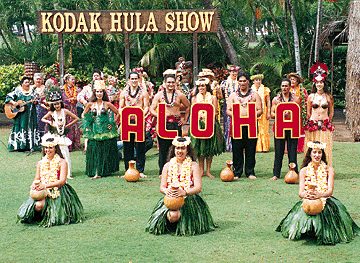
By Ken Sakamoto, Star-Bulletin
Kodak Hula Show cast members, above, pose for visitors
at the end of the show.


"I know this sounds so simple, but we are family, either because we are related by blood or because we're related by spirit," said Delphine Rickard, who has been with the show 59 years. "I love it. There wasn't ever anything else I wanted to do. Nothing."
The show celebrates its 60th anniversary this year. It is the longest running continuous performance in Hawaii and has been seen by nearly 10 million people.
On a very special day last week, there were smiles, hugs, kisses, sharing and encouragement as the troupe marked its anniversary. There were even some tears of joy rolling down smooth brown cheeks among the old and the young, the new and the veteran, the retired and the still performing.
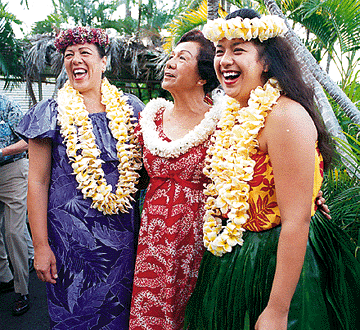
"The passing of the torch, yeah," Bite says, an enormous smile of pride filling her face as she hugs her granddaughter. "This is our culture and this is one way we share it. People have aerobics and running; this is my rush."
The Kodak Hula Show, which for decades performed at Sans Souci near the Natatorium until then-Mayor Frank Fasi expelled them from the site, was the brainchild of Fritz Herman, vice president and manager of Kodak Hawaii back in the 1930s.
Herman started the show in 1937 because visitors had no chance to film the hula in daylight since all the shows were at night or evening. Film speed just wasn't fast enough for night shooting without using flashbulbs, something frowned upon by nightclub owners.
That first show had five dancers, four musicians and 100 people attending. Since then, the cast has swelled to 20 female and six male dancers, 15 musicians and two chanters. Audiences number as many as 3,000 a week.
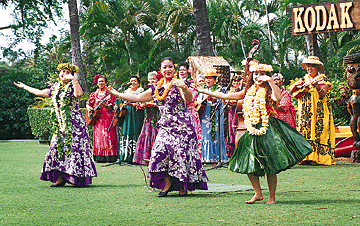
In the rustic backstage area on this day a dozen, thick leis of orchid, blue jade and plumeria lay on two concrete benches. Performers from 18 to 70-plus crowd under thatched roof huts adjust hula skirts, muumuus, hats and makeup, brushing hair and holding impromptu rehearsals.
Colorful carpet remnants are used as cushions to cover wood benches. Mirrors hang crookedly on walls next to song-and-dance schedules. In a narrow area near a chain-link fence, mothers and tutus change from street clothes to costumes.
Red-and-yellow signs which spell "H-a-w-a-i-i," which the "hula girls" carry during the show, are piled against a mat-covered fence
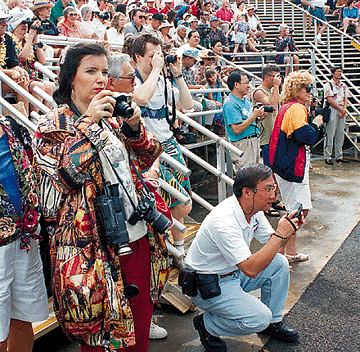
Over Diamond Head crater, a wispy, low-hanging cloud moves closer; the drizzle is backlit by the morning sun.
"It's the aunties' blessing us," says 71-year-young May Brown, director of the show and its host. Brown succeeded her aunt, Louise Akeo Silva, whose Royal Hawaiian Girls Glee Club still provide the dancers.
"I started dancing in the show when I was 14," Brown says. "We used to have quite a few school- age girls, but the Board of Education got after us when the girls started cutting classes."
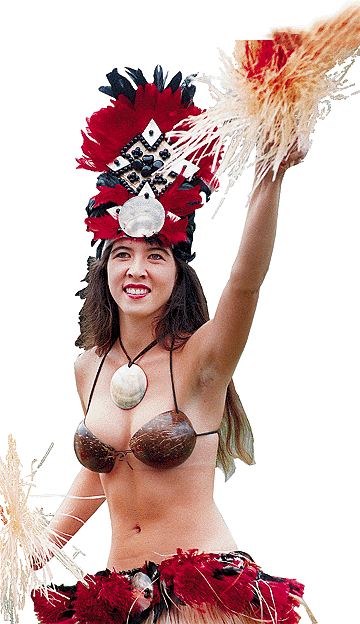
At his own tiny, thatch-covered dressing room, Wallace Akeo, Brown's cousin, sits on a stool, thinning the stems of palm fronds which the women performing Tahitian dances will use to fasten ti-leaf skirts. Akeo, a retired Honolulu police officer, has portrayed King Kalakaua and has played Tahitian drums in the show for about five years.
"When I was working in Waikiki, some days it would be really hot so I would look for a cool spot and stop at the Kodak show," he said. "I thought they could use a little bit of help on the Tahitian drums and here I am." Wallace recalls visiting the Sans Souci shows when his mother played music and his sister danced.
"This is all positive," said Akeo, 54. "I meet a lot of people from all over the world and it's always under good circumstances. I think most of the visitors have this 1940s image of Hawaii, you know before the skyscrapers of today. We try to transport them back just for an hour or so."
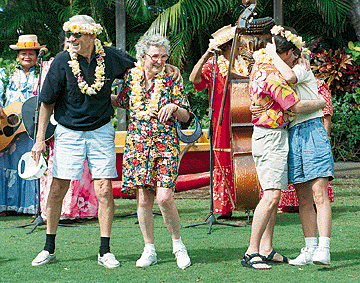
"The show is our effort to share a beautiful time of Hawaiian music and culture to visitors," Kahoano later says backstage. "But it's these ladies who carry on the heritage; they are the stars."
Despite location and performer changes during the years one thing that remains the same, the veterans agree, is the audience's reactions.
"They just stumble over you to talk and take a picture," Rickard said. "Especially the Japanese people; they're so cute, so eager to get close."
"When the show is over I always receive the most beautiful compliments," Brown added. "People love us."
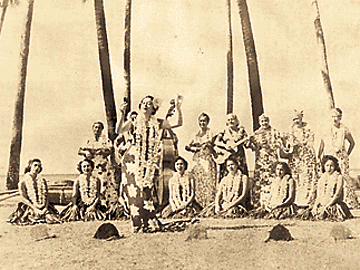
That's good news, especially for the older performers who have no plans to retire."
"Every year is always going to your last year but you keep hanging in there because you don't want to leave your family," Bite said.
"Stop?" said Akeo. "Maybe when my legs stop working. This keeps us younger a lot longer. Look at all of us."
Brown says she'll remain with the show until "I simply can't do it anymore."
Rickard echoes her sentiment: "When I can't sing or hear then maybe, maybe I said, I'll be gone."
The tradition is not lost on "rookies" like Dawn Kahala, 21, Brown's granddaughter.
"It's such a fun place to work, everyone's nice," she said. "I want to be like my grandmother and go on forever."

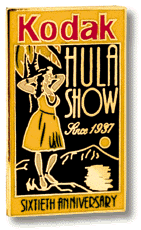
What: Kodak Hula Show
When: Tuesdays, Wednesdays and Thursdays, 10 a.m. to 11:15 a.m.
Where: Waikiki Shell grounds at Kapiolani Park
Cost: Free
Call: 627-3379